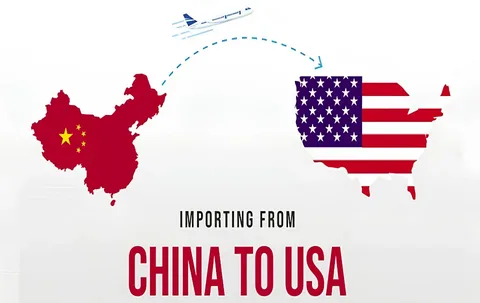
Meta Description: Find the complete details about the shipping rates between China and US: cost, ways, what influences its prices, and the best pieces of advice on limiting the spending on shipping from china . A step by step guide to importers and businesses.
Introduction to China-US Shipping Costs
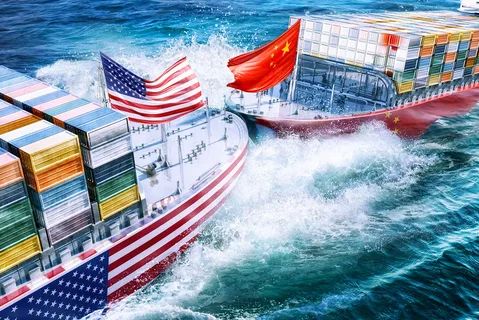
The transportation of the goods between China and the United States is one of the most active routes in the world of trade and millions of dollars of merchandises arrive every year. Shipping costs are important to understand by the business companies pengangkutan udara costs, the importers and also the individual who plans to transport goods to the west to the Pacific. The costing complex includes many factors such as base shipping charges, fuel surcharges, custom costs and numerous handling charges that may hit your bottom hard freight forwarder.
The shipping industry changed significantly in recent years, and technological changes, new trade policy, and world events transformed the way in which goods are delivered between these two economic giants china to the usa. Whether it is a small e-commerce shipment or a huge volume of containers, both have their pricing models and factors affecting shipping prices that can be well comprehended by a smart shipper in order to minimize his logistic expenses.
Understanding Different Shipping Methods
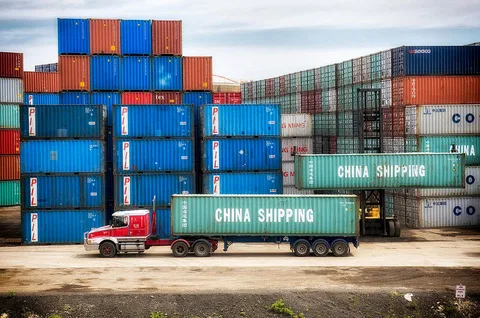
In case of a shipment between China and US you will have multiple forms of transportation to use, these would have different price systems and time span of delivery air freight shipping prices. Air freight is the quickest mode that usually takes 3-7 days but at premium prices that are 5-10 times the cost of the sea mode. This is the most suitable way when dealing with time-sensitive, high value or light products where fast delivery is worth the extra cost sea freight shipping cost.
Ocean freight is the cheapest mode of delivering large quantities although it takes 15-35 days depending on the ports where it will be delivered. This is because it is more economical in volume transfer and as such, it is the most commonly used when large quantities of goods are to be shipped especially since manufacturers and high-volume importers are able to build stocking around slower transportation speeds cheapest shipping.
Express carrier services such as DHL, fed-Ex and UPS act as an intermediate option with faster delivery than shipping by sea and reduced per kilogram rates compared to the conventional air freight port to port. Such express air freight services are especially used in e-commerce deliveries and deliveries that are business-critical and which concern both time and price.
Air Freight Shipping Costs and Factors
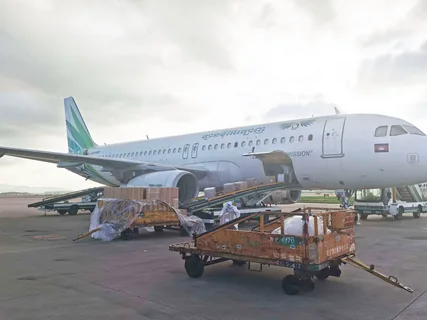
Air freight rates between China to US have a complicated rate formula that involves chargeable weight that can be determined between the actual weight or the volumetric weight whichever is greater as the chargeable one express freight. The formula of volumetric weight (Length dotted Width dotted Height dotted 6000 if they are in centimeter), this frequently becomes the determinant of the final air freight shipping cost of an item that is heavy to carry and light to search. Packaging optimization is important when it comes to controlling costs.
The latest available air freight prices are usually between 3-8 dollars per kilogram in general cargo, but the prices vary with the changes in the fuel prices and with demand and availability of the freight space. During peak periods especially before Chinese New Year and during holidays in the West, the rate may rise even up to 20-50 percent because of the demand and inability to provide more flights.
Still, there are other surcharges which airlines also apply such as fuel surcharges, security surcharges, handling charges each of which can add between 15-25 to the base rate added to fares. These other charges should be known to properly budget since they may greatly affect the overall sea freight costs of shipping your consignment.
Sea Freight Shipping Expenses
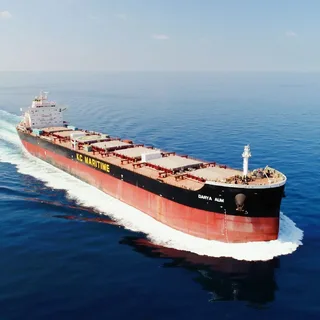
Sea freight shipping containers charges are usually charged not by weight but by the container hence very economical when the cargo is shipped in bulk. The typical rate of a 20-foot container (TEU) between mainland China ports and the US ports is in the range of $1,500-4,000, and a 40-foot container (FEU) is in the range of 2,000-6,000 depending on the route performed and market conditions prevailing at that time.

Less than Container Load (LCL) consignments are priced at a rate of cubic meters, up to an average of between 50-150$ per CBM. This is convenient with lower volumes that would not be sufficient to fill a container but this is associated with more handling costs because the container has to be consolidated and deconsolidated at both end of the origin and destination.
Sea rates are particularly impacted by port congestion, ship capacity and season. The trans-Pacific trade has been subjected to high bouts of volatility in recent years, encountering as much as 200-300 percent spikes in average freight costs when demand is at its peak or when the supply chain is experiencing delays.
Express Shipping Service Pricing
International express services provide a certain predictability on the price and dependability on the delivery time thus making it attractive when shipping time-sensitive goods. Express companies such as DHL, FedEx, UPS and others offer penghantaran ekspres cost delivery of documents and small packages at the rate of approximately 15-30 dollars per kilogram with a discount rate becoming lower depending on the volume of shipments.
Express services also take into consideration an in-depth tracking and provide opportunities to take insurance so as to deliver door to door; it will create further convenience but it will also make the service more expensive. Such services boast of superior customer and resolution services over normal freight practices and are therefore worthwhile to high stakes shipments.
Economy services are also available though express carriers which offer a little higher period (5-8) days but at lower cost of transportation i.e. 20-30 cheaper than the premium services. Such solutions may give the best trade off of price against performance with a great number of business applications.
Rail Freight via China-Europe Railway
Although it does not directly connect US and China, Chinese-Europe Railway Express presents an exciting alternative route pass Western transshipment in Europe. Sometimes, this service offers savings in costs and transit time relative to conventional sea freight, at least to some inland destinations of the US.
The transporation cost of rail freight usually happens to be 50-70 per cent higher than sea freight but 40-60 per cent shorter, that too, is a good middle ground. The medium-valued goods can use the service because it is faster and less laborious than using the ocean fleet and it is cheaper compared to the air fleet.
But rail transport to US involves further transport to European ports hence complicates and expose them to periods of delay. This alternative is preferable to shippers who are able to utilize European distribution systems or whose supply chain flow is adaptable.
Factors Affecting Shipping Costs
The prices of shipping products or goods ordered in China to the US depend on many variables including shipping cost from china , but weight and size of shipment are a few leading ones. One method utilization by carriers is dimensional weight where by calculations are made as one way to guarantee that profitability is made on lightweight yet bulky products, thus optimization in terms of cost is found in packaging efficiency..
The impact of destination location is also notable since the main ports and cities usually have better rates since they provide larger volumes and competition. The additional remote or inland destinations are associated with extra charges of trucking in cost and handling cost that may impose 20-50% on the cost of base shipping.
The change in demand causes huge price fluctuations as it changes with seasons. Rates may surge during peak seasons leading to major holidays, back-to-school, and during the Chinese New Year since we are operating under capacity and there is an increased demand by retailers who want to ensure the rushes by consumers.
Weight and Dimensional Considerations
The accurate estimation of costs depends on the understanding of the system used by carriers to calculate chargeable weight. An air freight will have 6:1 volumetric weight ratio (6000 cubic centimeters per kilogram) whereas express services may have 5:1 ratio. This implies that a heavy, yet small amount, package can turn out to be very expensive as compared to the amount that has been calculated using weight as a factor.
Shipping costs are easily cut by optimizing packaging which minimizes the calculation of dimensional weights. The idea that a tiny box can be used, that much packaging should be avoided and that several shipments could be combined can save so much money, especially in cases of air freight and express deliveries.
Carrier pricing structures the opportunity to optimize costs provided by weight breaks. By knowing such thresholds, the shippers can then perhaps combine such shipments or split them strategically in order to obtain a better per-unit rate.
Distance and Destination Impact
The distance between the geographic locations will influence the price of shipping but the influence is not linear because of the existed shipping routes and efficiencies of ports. The West Coast West Coast destinations such as Los Angeles and Seattle normally have lower prices and shorter China transit times than East Coast ports.
Inland destinations need extra transportation by land by truck or through rail, which increase the cost and the time of delivery. There are extra charges that may cost between 200-1 000 dollars depending on the distance and market forces of the area.
The choice of port can have dramatic results on overall cost and product lead time when working with a freight forwarding company . The large ports have regular services and reasonable prices but can get congested at the peak times. It may prove to be cheaper but not as fast as a primary port with restricted services and slow clearance at secondary ports.
Turun Naik Harga Bermusim
China to US shipping has a high rate of seasonality that is influenced by retail seasons, production trends and holiday traffic. August to October is usually the peak season as retailers gear up to supply during holiday seasons and back to school needs.
The Chinese New Year causes some peculiarities in the shipping opportunities and prices because lots of factories close during this period of time (2-3 weeks). This results in a surge of demands before and after the holiday which, in turn, usually comes at the cost of rate increases of 30-100 percent on air freight and express services.
Sea freight can provide more stable rates during summer months, with disruption and rate increases caused by the typhoon seasons being temporary. Flexible shippers can save on cost with plans based on these season patterns.
Fuel Surcharges and Additional Fees
Fuel charges are a major element on the shipping costs with an average increase of 10-25 percent on basic freight rates based on the oil price conditions and the tariffs of the carriers. These are monthly surcharges, which are used to cover the differences in fuel costs of carriers.
Additional charges to the total cost of shipping are security fee, handling fee, and documentation fee in addition to base rates and fuel surcharges. This price is between 25-200 dollars per shipment considering the type of service and the provisions of the carrier.
Another aspect that raises the bills during peak seasons is surge pricing and capacity adjustment factors. The temporary surcharges amount to an addition of 25 to 50 percent on the shipping costs during peak seasons, and the timing of the shipments is thus essential to the cost-conscious shipments.
Duti Kastam dan Cukai Import
The US taxes on imports are extremely different depending on the type of product, country of origin and existing trade policies. Appreciating Harmonized System (HS) codes and duty rate is vital in the calculation of total cost since most products attract Duties between 0% and above 25% according to their lines of the products.
Customs brokerage costs are generally calculated on a per shipment basis withoresis of the amount being charged on each shipment being between 50 to 200 dollars however, charges can be higher depending upon complexity of each entry. These charges are used to include the costs of preparing documentation, communicating with the custom and complying with regulations.
More taxes like state sales taxes can be charged on the imported goods and this taxes differ on matters of destination and the type of the goods. Others may also make use of taxes over the goods bought outside the state of supplier with an addition to the total cost of the imported goods as well.
Insurance and Protection Options
Cargo insurance insures against loss or damage in transit and normally comes at a premium of 0.1-0.5 percent of value of shipment. Insurance is strongly advised on precious consignment especially as expedited freight distances are long with numerous handling points.
Coverage comes in different levels which include basic coverage that is used to cover the possible loss of the whole cargo and comprehensive coverage which can be used to cover partial damage, delay, and other risks. Knowledge of the conditions under the exclusion of a policy and guidelines must be followed in successful risk management.
Self-insurance programs that result companies in accepting small claims instead of buying insurance may be economical to high-volume carriers with loss rates that can be forecasted. The method, however, involves a proper risk evaluation and sufficient financial amounts.
Documentation and Compliance Costs
Clear documentation is essential to facilitate clearance over the customs and evade losses and fines. Major documentations that assist in the shipping process such as commercial invoices, packing list, bill of lading and certificates of origin are normally required but preparing them may cost.
The US import laws, such as food product FDA requirements, electronic product FCC certification and other agency requirements, may impose enormous costs and complexity into the importation process. Such requirements are determined by the type of products shipped and should be learned prior to shipping.
Errors in documentation may incur expensive delays, cost of storage and penalties. Engaging skilled freight forwarders or customs brokers will assist to achieve this and reduce these risks although it will increase the overall cost of shipping.
Packaging Requirements and Costs
Shipping of goods internationally involve good packaging which is able to withstand handling, exposure to weather conditions and time spent in transit. Appropriate packaging material and methods may also increase shipping price (by 5-15 percent) but are necessary in order to safeguard goods and prevent damage claims.
The packaging standards to be used in exports are likely to vary with the packaging standards within the country with international exports needing stronger package material, safe moisture protection, and transparent packaging. Knowledge on these requirements assists in the elimination of repackaging costs and delays.
Research into how to optimize packaging takes into account the requirements of calculation of dimensional weight, the protection requirements of any goods or commodity while making sure that this is cost effective. Such intelligent packaging decisions can lower the cost of packaging by minimizing the cost of packaging as well as the dimensional weight cost, which amounts to twofold saving.gs.
Container Loading and Handling Fees
When loading containers the charges also depend on whether you opt-in to Full Container Load (FCL) or Less than Container Load (LCL). Shipments of FCL services are usually associated with lower per-unit handling costs, although they need reasonable quantities to warrant that the entire container is filled.
LCL shipments include consolidation and deconsolidation processes, meaning that each unit costs more but allowing the treatment of smaller amounts. An awareness of these cost differentials assists in composition of the most cost effective mode of shipping by your volume.
There are charges due to facilities at the terminals and storage, container deposits, and operating-positioning charges that charge in addition to basic freight rates. Charges differ widely among ports and carriers so that cost comparison is useful when choosing a route.
Port Selection and Their Cost Implications
Most of Chinese ports such as Shanghai, Shenzhen, and Ningbo service to destinations within the US are highly competitive and frequent because of the amount of cargo being moved combined with the competition within the carriers. These ports can however be faced with congestions during peak seasons.
Destination ports through the US also have a major effect on the overall costs and delivery. West coast ports tend to pose a better sea freight rate and shorter transit time from China whereas East coast ports could be better regarding access to the inland but not because of lower ocean freight prices.
The shipping costs also depend on port efficiency, pricing of labor and quality of infrastructure which influence their reliability. New, more efficient ports have the potential of generating higher fees but delivering better turn time and minimized chances of experiencing delays that may cover the increased cost through supply chain dwell time savings.
Consolidation Services and Savings
Freight consolidation enables the small-scale shippers to gain the bargaining power of the large shipments by pooling together shipments into other clients. The service allows the reduction of the costs of shipping by 20-40 percent compared to shipment of small quantities separately and, as such, it is appealing to e-commerce and small business operators.
The transit times are usually extended by 2-5 days by the process of consolidation services, i.e. collection, sorting and redistribution. Nonetheless, the savings which are usually incurred usually make it worth time spent on non emergency shipments.
The consol service companies also compete with direct shipping by offering similar functions of tracking, insurance, and customer service and offer the same benefits at a lower cost than perfect volume pricing. When selecting consolidators it is essential to select those who have a reputation of being reliable and providing quality services.
Comparison Shopping for Best Rates
Shopping between a variety of carriers and freight forwarders can provide significant savings and the quote on one shipment can differ by 20-50 percent between similar carriers. Nevertheless, the actual comparison of rates is only possible when it is clear what services and charges are enveloped within each quotations.
On the internet freight marketplaces have proved to be useful in rate comparison whereby the shipper can get quotes within a short interval in time using various suppliers. The platforms usually come with other services such as tracking, documentation as well as customer support.
Establishing a healthy relationship with carriers and forwarders that they prefer, can result to a volume discount and preferential treatment especially with regular shippers. Long- term relationships tend to that better service performance and problem solving compared to transactional relationship.
Volume Discounts and Negotiation Strategies
Regular shippers are able to bargain heavy volume compensations, due to annual air freight cost shipping amounts or guaranteed customers. Such discounts may be anything between 10-40% to published rates whereby such volume commitments are useful in limiting shipping patterns.
The approach to negotiation must be based on an overall spend in shipping, service requirements, and flexibility requirements and not only base rates. Nationwide contracts that include several services and trade lanes are usually more valuable in terms of overall value than route-specific deals.
Freight forwarders usually negotiate with carriers better because of their pooled business, which enables them to send cost-savings to the customer. Connection through forwarders may even offer lower rates than individual carrier negotiation to smaller shippers.
Technology Solutions for Cost Optimization
Transportation Management Systems (TMS) are a package that assists the optimization of shipping expenses by automated rates shopping, route optimization, and carrier performance tracking. These systems are able to determine cost savings and increase the efficiency of shipping to regular shippers.
The real-time tracker and analytics mean that most visibility platforms can be used to identify cost drivers and places to optimize. Shipment and Information about shipping quantities and performance rates can support decision-making and can be used to determine routing, time and transportation company choices.
e-commerce platform and ERP API can be used to improve shipment processes and avoid manual errors which may incur extra-costs. Automation is useful in that it corrects records and proper mode of shipping is chosen.
Small Package vs. Freight Shipments
Shippping small packages less than 150 pounds are usually done using express services or postal services, the charge will depend on the weight, size, service level charged. Such shipments are convenient and trackable but with costs per pound than freight services.
The freight shipments exceeding the 150 pounds weight are able to utilize the freight pricing arrangements that are more economical. Knowledge of the break point of the line between small package and freight rates allows one to minimize expenses of shipments around these break points.
Medium size transport is seeing the development of hybrid services that integrate the convenience of a small package with freight economics. Such services are able to offer the best balance between costs and services where shipments do not conform to classical categories.
E-commerce Shipping Considerations
Unlike regular e-commerce deliveries between the countries, the shipments between China and the US consumers are unique as they have the challenges of customs clearance, duty collection, and delivery to residential areas. Such variables may greatly influence the overall expenses and customer satisfaction.
De minimis limitations have an influence in the collection of duties and taxes where shipments of value below 800 dollars do not require a formal customs entry. ## Knowledge of these thresholds allows one to best manage the values of shipments and costs of custom processing.
E-commerce involves returns and warranty logistics which increase the cost and complexity of the business and brings the reverse logistics cost in the calculation of the total shipping cost. Such expenses may greatly influence profitability of some product groups.
Dangerous Goods and Special Handling
Special handling, documentation and equipment is needed to handle hazardous material which leads to premium costs. It is important that the affected shipper understand the requirements and the classes of dangerous goods so that they can be able to plan their budgets.
Shipment covered by special handling requirements, including temperature control and oversized shipments, comes at an extra cost that may be doubled or even increased three times regular rates of shipping. Special services entail planning and analysis of cost.
Specialty categories of cargoes bring the regulatory compliance, which is complex and could be costly when not handled properly. Cooperation with the professionals will contribute to the compliance with the rules and to avoiding any extra expenses.
Environmental and Sustainability Factors
Green shipping and carbon offset programs are increasingly cited as priorities to environment-friendly shippers. Although these alternatives are likely to be premium, they will be worthwhile to companies that are environmentally-friendly.
Environmental impact and fuel surcharges can also be decreased by fuel efficient routing and equipment. Cost benefits are frequently found in carrier state-of-the-art, efficient devices, environmental advantages.
The future availability of shipping may be affected by the tendency towards environmental conformity with controls over emission emissions and carbon taxes being established. Projecting what might change is a way of future proofing shipping strategies.
Economic Factors Affecting Shipping Rates
The global economic factors are very influential on the shipping market, both in terms of demand and rates; economic upward trend positively increases the trading volumes and these rates may rise. Learning how to read economic indicators enables one to know the trend in the rates and base on that.
The exchange rates of the currencies influences the comparative cost of shipping services especially in international business deal. Strong USD tends to lower the cost obligations of the US importer, whereas the weak US dollar hikers relative cost of shipping.
A shift in trade policy such as through tariffs, trade agreements and regulatory adjustments can significantly affect shipping patterns and cost. Monitoring the policy boundary assists in predicting the cost changes and compounding policies accordingly.
Future Trends in China-US Shipping
Digitalization and automatization of the shipping operations promise to decrease the cost of operations by increasing efficiency and helps in easing manual processing. Such technological innovations might remodel prices and the services to be provided within the next few years.
New routing directions, such as the Arctic maritime routes and the dense rail routes, might offer China-US trade to even increase its cost-time benefits. This type of keeping track will lead to the discovery of the opportunities that arise.
The carriers are still reshaping competitive forces due to capacity increase and provision of new services. Appreciating the market trends enables the shippers to position themselves in ways that can take advantage of better services and fair prices.
Cost-Saving Tips and Best Practices
Advance planning means that the shippers will not pay the rush charges, and more favorable rates will be available in off-peak periods. The flexibility in scheduling may save much money due to the best timing and routing decisions.
Compliance Packaging The situation in which the dimensional weight rates are lower and the product safety is not compromised is called packaging optimization. A regular shipper can achieve continuous cost-savings opportunities by investing into packaging design and materials.
The development of good relationships with the logistics companies provides the best services, favorable prices, and addressing the problems before they arrive. Historically and scientifically the long term relationships tend to present more value, as compared to the transactions on the lowest rate application linkages.
Bekerja dengan Freight Forwarder
The freight forwarders offer specialised knowledge, connections and bulk benefits that can be useful to every sized shipper. They are usually worth 10-20 percent of a shipping cost but save money more frequently due to nicer rates, and less errors.
When selecting the forwarder, the issues of experience, the capabilities of services, the level of technology platforms, and quality of customer services should be considered, not necessarily only the prices. A strategic advantage can be gained through the right partner other than cost-saving.
Forwarder-based service level agreement acts as an adequate benchmark to maintain performance levels and control along with giving predictability on costs. Clearly defined duties and achievements benefit both the parties.
Mengenai GWT Worldwide
Shenzhen Guanwutong International Freight Forwarding Co., Ltd. (GWT Worldwide) is a professional logistics service provider majoring freight forwarding in the world, supply chain solution, and cross-border e-commerce logistics. As being an expert in airfreight, seafreight, China-Europe Railway transport, and custom clearance services, international express delivery, warehousing, and Amazon FBA support, GWT Worldwide ensures client products delivery with the high quality and low costs due to the advanced technologies and a world-network of reputable partners.
Kesimpulan
To know how much shipping fee will be charged when shipping products between China and the US, it is necessary to have an in-depth knowledge of various elements such as modes to be used, the structure of the shipping price, seasonal differences, and legal obligations. International shipping is such a broad endeavor that saving costs in one place might be balanced by augmented costs elsewhere and thus total costs comparison is one of the key decision making tools.
Cost management can only be successful when a regular awareness of the state of a market, development of relationships with suppliers of logistics services, and seasonal and volume planning are involved. Most economic strategies tend to lie in balancing several things as compared to settling the lowest rate quoted.


Thank you for reading!
Have questions, corrections, or better ideas? We’d love to hear from you!
We value every piece of feedback and promise to reply within 24 hours. Let's make this guide better together!
Note: Spam comments will not be published.